Home Improvement
Understanding Permitted Development Rights in London
Published
2 months agoon
By
Prime Star
Most people will ask themselves if they need planning permission before considering development options related to the conversion, development, or enhancement of existing properties. The answer is typically no in terms of Permitted Development Rights. Permitted Development rules allow specific criteria and limitations to be followed, such that some projects can be accomplished without the need for a full planning consent.
However, if you are managing a project that already has planning permissions in London, things may start to get a little more complicated. Because of the large number of conservation zones, grade 2 listed buildings, and borough policies, being aware of exactly what is and what is not acceptable is critical. This blog is intended to provide all of the information a homeowner or design professional will want to know about London’s existing development rights, what they mean, and how to tell if your project adheres to those development rights.
A Homeowner’s Guide to Permitted Development Extensions and what can you build under PDR
Permitted Development Rights (PDR) originated as a collection of national planning policies that permit some building works and change of use without needing full planning permission. The guidelines also apply to residential and non-residential properties and help to simplify the planning processes for developments that are relatively minor, quicker and more straightforward.
To be considered Permitted Development, your extension must follow several basic rules. The extension must not exceed 50% of the land around the original property, and the materials used must be ‘similar in appearance’ to the existing property. It must not extend beyond the principal elevation of the dwelling, which refers to the front of the house that faces the road, and it must not have balconies, verandas, or raised platforms.
The maximum depth of a single-storey rear extension is 3 metres for terraced, and semi detached dwellings and 4 metres for a detached dwelling. The maximum depth can increase to 6 and 8 metres respectively under the Larger Home Extension Scheme, but this enhanced application must have prior approval from the local planning authority. The overall ridge height must not exceed 4m and the eaves height must not be more than that of the existing house.
Permitted development for side extensions is only applicable for single-storey extensions that are no more than half the width of the original house and less than 4 metres in height. For double-storey rear extensions, the extension must not project more than 3 metres from the rear wall, and be at least 7 metres from the rear boundary. Any upper-floor windows that are on the side elevation of the extension must be obscure-glazed and non-opening below a height of 1.7 metres from floor level.
Permitted Development Outbuilding Rules
An outbuilding can only be considered to be Permitted Development where it meets the following conditions. The outbuilding must be a single-storey building and must not exceed 50% of the total area of the land surrounding the original house. Eaves height must not exceed 2.5 metres and the maximum total height of the outbuilding is limited to 4 metres for a dual pitched roof (e.g., 2 slopes) or 3 metres in height for any other type of roof. If the outbuilding is located within 2 metres of a boundary the overall height must not exceed 2.5 metres. The use of the outbuilding can only be for ancillary purposes (e.g., home office, gym and playroom) and must not be used as living accommodation (e.g. bedroom, living room). If your property is a listed building or located in a conservation area it is common for permitted development rights to be restricted or removed which would require planning permission to be acquired before building a detached outbuilding.
If you are considering work, always check with the guidelines of your local planning authority or apply for a Lawful Development Certificate for clarification that your proposed works comply. There are certain benefits of completing your development under permitted development, mostly you can complete the works without the delay of applying for planning permission, if done correctly!
Key Differences Between Planning Permission and Permitted Developmen
When remodeling your house (or extending it), it is important to understand the difference between permitted development rights (PDR) and planning permission, as both of these processes determine whether your project can proceed legally.
Planning permission is the formal approval from your local council to build a building, change the use of land or property. It is required for larger or more complex projects that could affect surrounding residents, the environment or local character. The process, which may involve the submission of drawings, impact assessments and the payment of application fees, usually takes several weeks.
On the other hand, Permitted Development Rights allows for certain types of works (small extensions, loft conversion or garden buildings) to take place without the need for full planning permission as long as the works fall within tolerable limits on size, height, and design. PDR represents a quicker, and simpler means of altering your home in a modest way.
Nonetheless, there are instances in London when these rights may be curtailed, typically through Article 4 Directions, in relation to conservation areas, or where the property is a flat or listed building.
To summarize: planning permission necessitates approval from the local council, whereas permitted development is readily available and operates automatically within specified rules. Knowing whether you require planning permission or are eligible for permitted development, will give homeowners some peace of mind that they are planning accordingly and not wasting their money on costly mistakes.
Restrictions and Exceptions Across London Boroughs
While homeowners can more simply extend or change their properties without making a full planning application, under Permitted Development Rights (PDR), they understand that PDR is different from borough to borough. To conserve local identity, cultural heritage and quality of place, each council may apply its own restrictions.
Many authorities use Article 4 Directions to remove or limit PDR in certain areas in London. For example, boroughs like Westminster, Camden and Kensington & Chelsea limit changes to the facade or create conversions to historic streetscapes. In order to strike a balance between housing and workspace, boroughs like Hackney, Islington and Tower Hamlets have removed PDR for office to residential conversions.
Generally, permitted development rights do not apply to residential properties within a Conservation Area and to listed buildings, apartments or maisonettes, and any building (or part of a building new or existing) you wish to work on will have to comply with some very strict limits on size, height, and materials even when it is permissible.
What is permissible in one part of London may require full planning permission in another as restrictions differ on a borough-borough basis.
How Extension Architecture Helps You Make the Most of Your Rights
This is an excellent moment for people thinking about a project, especially if they do not wish to have to go through the process of planning permission. The recent proposals from the UK government feel have been rewarded to house owning people, as a real chance to plan again, and revive their aspirations for their home, gardens, amazing spaces, and of course, good living space. If you are on the brink of preparing your grand designs, the first thing you should do is contact your local authority. Having confirmed the new Permitted Development rights 2025, will put you in a great position to move ahead with a constructed plan and strategy for your project.
If you want to get started, we can help you with an initial consultation that involves planning consultation, design, and detailed budgeting to give you an idea of where you stand with your plans.
As a seasoned and trusted practice with over 17 years of experience and crafting expertise across London and beyond, we specialise in residential extensions, space conversions, and design and build. Our planning consultants have profound expertise in furnishing the complex planning applications to etch out the most functional and aesthetically pleasing structural outcomes you may have dreamt of.

Data Privacy and Confidentiality in Legal AI: Keeping Sensitive Matters Secure

Jodi Faeth: What Happened to Mike Wolfe’s Ex-Wife After Divorce?

How GEO Helps Startups Compete With Enterprise-Level AI Visibility

Who Is Cassandra Marino? Caitlyn Jenner’s Daughter Who Lives a Private Life

Get to Know Nathan Andersen: A. J. Cook’s Husband and Proud Family Man

From Digital to Tangible: The Human Impact of Cryptocurrency to Fiat Adoption

The Real Story of Melissa Meeks, Jeremy Meeks’ Famous Ex-Wife

MegaCustom: Personal Gifts Made Beautiful

Design Something Special with MegaCustom

Top 10 SEO Agencies for Barber Shops

Who Is Marlene Knaus? The Untold Story of Niki Lauda’s First Wife

Curious About JOI Database? Read This First Before You Click Anything

Jacqueline Bernice Mitchell: The Inspiring Story of Jerry Rice’s Ex-Wife

Should You Use Wooflix in 2025? Honest Review and Best Alternatives

Where Is Noelle Watters Now? Jesse Watters’ Ex-Wife’s Life After Divorce

Where Is Barbara Boothe Now? Inside Her Life After Larry Ellison

Alisande Ullman Today: What Happened After Her Divorce from Leslie Nielsen?

Where Is Tanya Hijazi Now?: All About Rick James’ Former Wife

Wendy Lang: Meet the Therapist Married to Cenk Uygur

Mickey Middleton: The Untold Story of Bryan Cranston’s First Wife

Data Privacy and Confidentiality in Legal AI: Keeping Sensitive Matters Secure

Jodi Faeth: What Happened to Mike Wolfe’s Ex-Wife After Divorce?

How GEO Helps Startups Compete With Enterprise-Level AI Visibility

Who Is Cassandra Marino? Caitlyn Jenner’s Daughter Who Lives a Private Life

Get to Know Nathan Andersen: A. J. Cook’s Husband and Proud Family Man

From Digital to Tangible: The Human Impact of Cryptocurrency to Fiat Adoption

The Real Story of Melissa Meeks, Jeremy Meeks’ Famous Ex-Wife

MegaCustom: Personal Gifts Made Beautiful

Design Something Special with MegaCustom

Top 10 SEO Agencies for Barber Shops
Categories
Trending
-

 Celebrity6 months ago
Celebrity6 months agoWho Is Marlene Knaus? The Untold Story of Niki Lauda’s First Wife
-

 Entertainment5 months ago
Entertainment5 months agoCurious About JOI Database? Read This First Before You Click Anything
-

 Celebrity3 months ago
Celebrity3 months agoJacqueline Bernice Mitchell: The Inspiring Story of Jerry Rice’s Ex-Wife
-

 Entertainment5 months ago
Entertainment5 months agoShould You Use Wooflix in 2025? Honest Review and Best Alternatives
